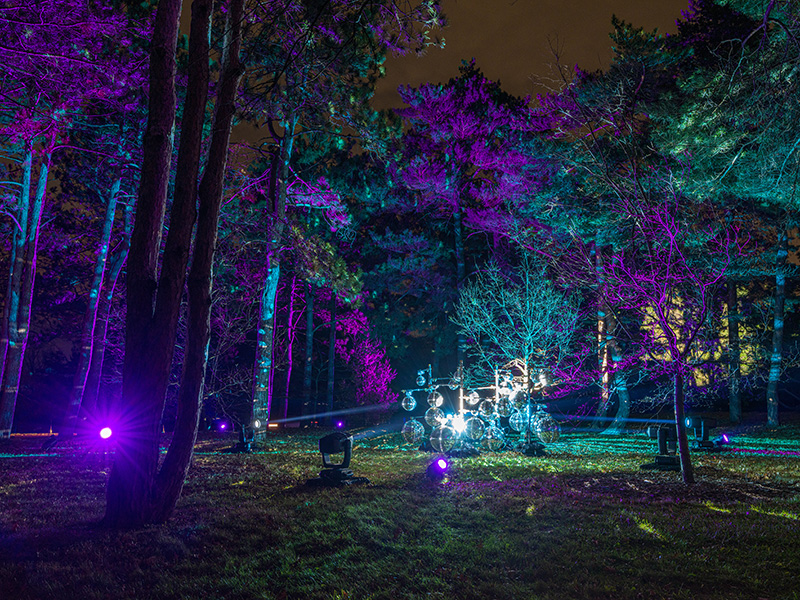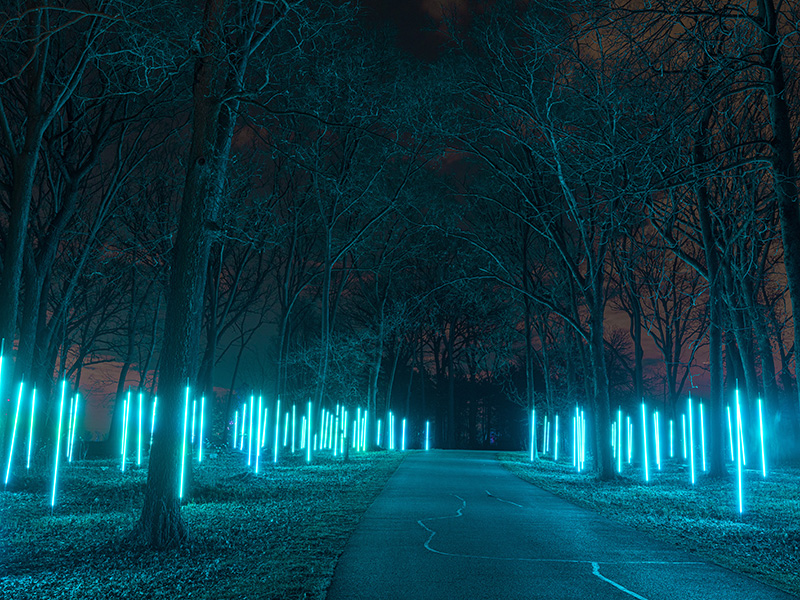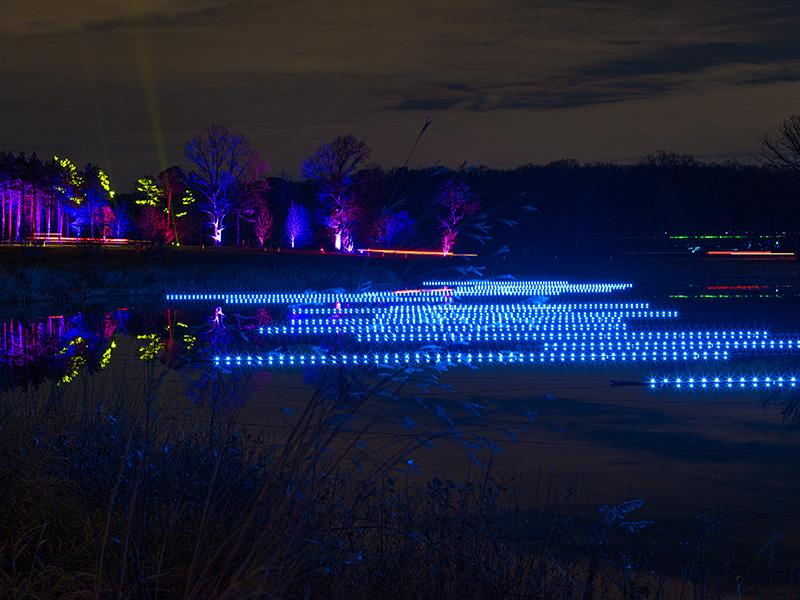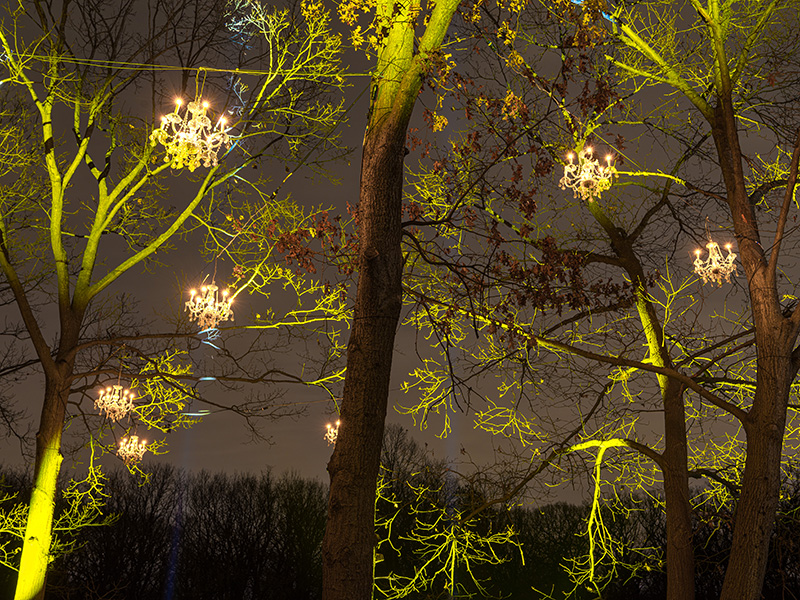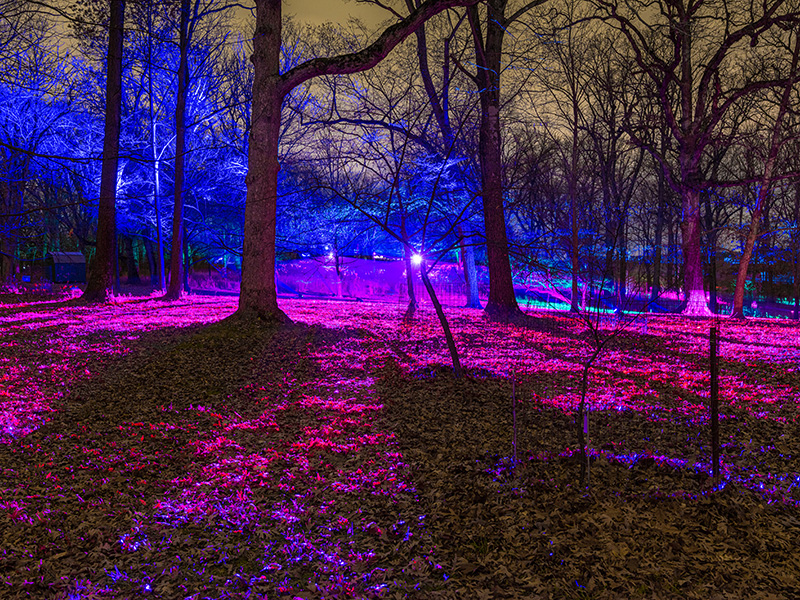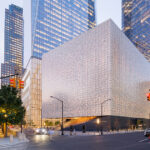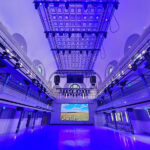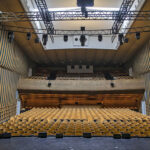
Lightswitch and ILC Pivot from Walk-Through to Drive-Through Attraction to Ensure Covid Safety
Although it was founded in 1922 by farmer-turned-salt entrepreneur Joy Morton, the Morton Arboretum was not always very well known to the general public. Dr. Gerard T. Donnelly, PhD, who was named executive director and CEO in 1990, sought to change that by organizing events and experiences that would attract more visitors to the institution while always striving toward the goal of helping people learn more about trees.
In 2013, the Morton Aboretum first worked with Lightswitch partner and principal John Featherstone and his team to develop Illumination: Tree Lights at the Morton Arboretum. This project has always been driven by a very nontraditional design approach, with more emphasis on the Arboretum’s mission to collect and study trees from around the world than on just the holiday season itself. By emphasizing the trees, and not just the decorations, the ultimate goal is one of conservation for a greener, healthier and more beautiful planet.
Over the years, Dr. Donnelly’s vision and Lightswitch’s creativity have turned Illumination into a perennial winter walk-through attraction for residents of the Chicago area and beyond. But as the 2020 event was being planned, it soon became evident that a radically different alternative to the walk-through design might be required.
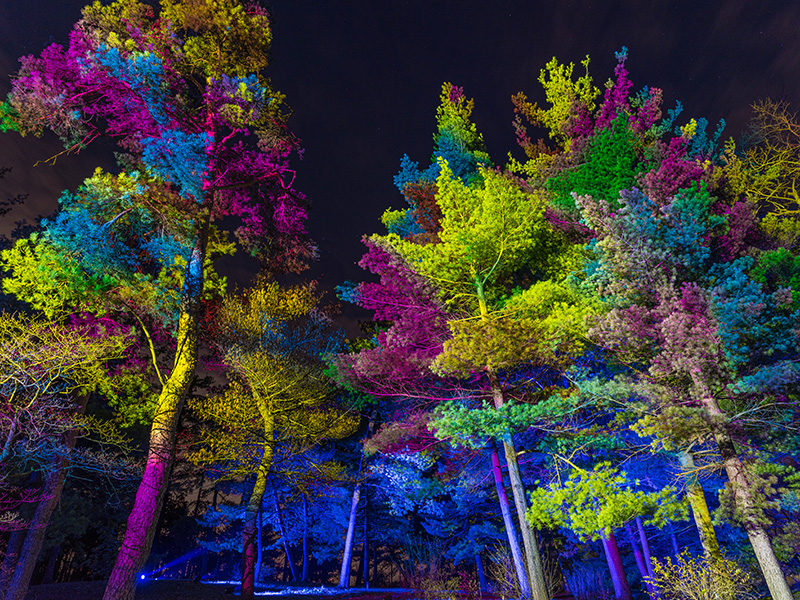
The Parallel Shift
“In the early discussions with the group at The Arboretum we ran through a series of what-ifs,” recalls Featherstone. “Like, what if this Covid thing really sinks its teeth into us? We did not want to get caught flat-footed.”
With visitor safety as the biggest concern, plans for the now-traditional walk-through experience were joined by a parallel plan for a drive-through experience in May. By August, the Arboretum and Lightswitch focused on the what they were positive they could do safely when the attraction opened in November. “We knew we could safely do a drive through experience, no matter what,” says Featherstone.
The Arboretum grounds are ample, covering approximately 1,700 acres. Roughly two miles of a drive trail were mapped out, including sections lit up in previous years along with new areas of lighted space. “This gave us an opportunity to essentially make lemonade out of lemons, opening the door to explore new ideas, new geography, habitat and different parts of the Arboretum,” Featherstone says.
Several aspects about the overall look of the experience would need to be rethought since they would be viewed from inside a car rather than outside walking on a path. But the goal of highlighting the beauty and grandeur of the trees themselves, rather than just the holiday decorations, remained.
“Exploring their shape and the way bark looks under a light — grabbing people’s eyes at the base of the tree, and guiding their gaze traveling the trunk all the way up to the magnificent crown of the tree — is the purpose of this mix of technology with nature,” explains Featherstone.
“Our challenge was how to translate that experience from inside a moving vehicle, because you lose a ton of that from inside a car,” Featherstone adds. Viewing trees through the narrow frame of the front windshield or side windows is not the same as walking among and between them. People are not as close to the scenery either, so some of the effects employed in previous years had to be left out.
Although the drive-through experience only partially replicates the immersive feel of a walk through an illuminated forest, the 2020 edition of Illuminations at the Morton Arboretum stands as an impressive Covid-era success, drawing between 1,200 and 1,800 carloads of visitors over a two-month holiday time frame.
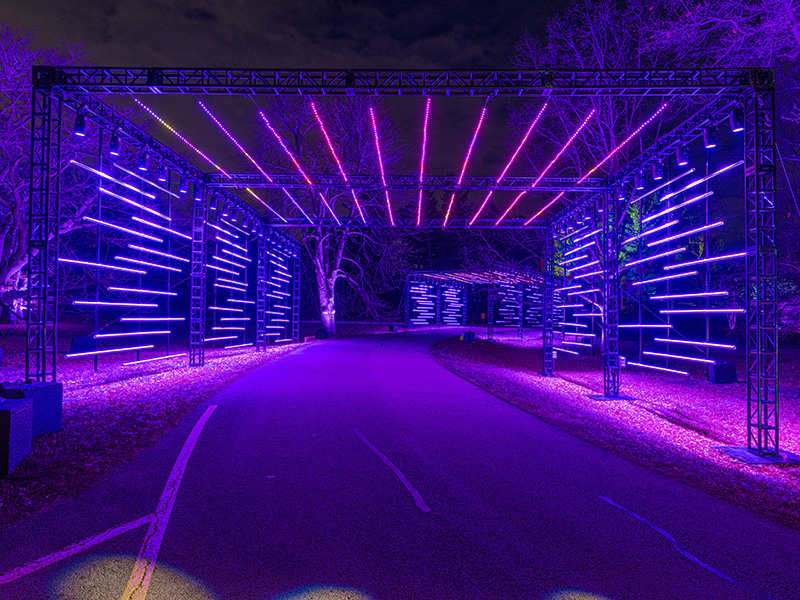
The Team
Along with the design challenges of the pivot to a drive-through experience, the team behind Illumination faced the logistical challenges of lighting up a more expansive area during a global pandemic.
As an annual installation project, Illumination is always “a big lift,” as Featherstone puts it, for both Lightswitch and their installation partner from the start, Intelligent Lighting Creations (ILC). But while ILC, which starts dropping cable on the grounds in September, might normally provide six miles of copper, the 2020 expansion to a drive-through format required 40 miles of cable. Fixtures were placed in October, and the creative and programming team went onsite late October. The month of November is dedicated to programming, and the show, which ran through Jan. 10, opened one week before Thanksgiving.
Scott Falbe, founder, and CEO of ILC, is a longtime project collaborator with Featherstone at Lightswitch. “The show is a lot bigger this year, and I must confess, I drastically underestimated what this pivot to a drive through experience would undertake,” Falbe says.
With equipment just sitting on the shelf due to the pandemic, he was able to throw more gear at the show to ensure success. That was not the case with labor, however. “Usually, we have 10 ILC crew guys doing 10 hour days for four weeks. The ceiling of how big the experience could be was only limited by how much gear these guys could set up in that same budget ballpark. [But] just because we had another hundred fixtures on the shelf at the shop did not mean we had the physical resources to deploy it.”
And the Covid-19 pandemic, of course, created other challenges as well. With the need for crew members from Lightswitch, ILC and Easy Live Audio working in relatively close proximity, rigorous protocols were adhered to throughout the project. This winter’s spectacle also required PPE, weekly testing and an on-site nurse practitioner to ensure no one got sick while on site. “There are a lot of people who were understandably and rightfully concerned about getting groups of people working together, and we did not go into this lightly,” says Featherstone.
Falbe is not fond of generators on show sites, particularly with Illumination, which is all about the natural canvas. For this reason and the size of the area the show took place in, the ILC team rolled out 40 miles of feeder cable that ran to six different satellite shed positions. These housed the control, data, and power distribution points. A fiber optic network provided the backbone for data distribution between the sheds and consoles. The lasers introduced to the design this year, “are a great way to really fill up a large space with very little infrastructure and very little equipment,” Falbe added.
Alex Konarski, a.k.a. “the hermit of Illumination,” managed the onsite turn-on and walk-through every day before the show opened. “He has an amazing eye,” points out Featherstone. “With an experience of this size, a good, trained eye is essential to make sure everything is working right and nothing is missing. Alex is part of our secret sauce — the glue that holds everything together when the creative team is not there.”
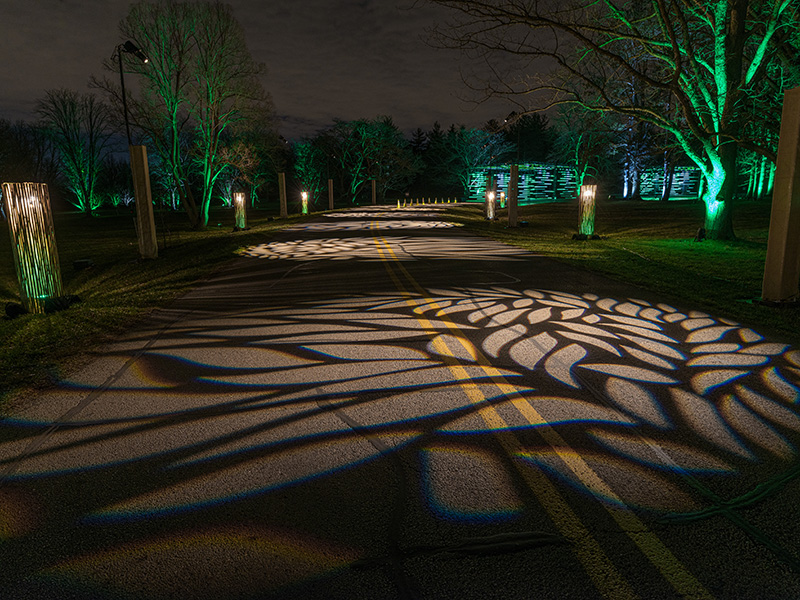
Design Choices
The primary collaborator and project director at the Arboretum, VP of learning and engagement Preston Bautista, Ph.D., understands the notion of working with curated spaces that guide people through a range of experiences. Not every room is necessarily the same — there are traditional pieces, there is sculpture, and there may be a modern wing, for example.
“We try to do the same thing with the Arboretum,” notes Featherstone. One of the underlying themes the design team seeks to achieve with Illumination is to curate different areas of the Arboretum like curating a museum.
Fixture selections were based on past experience and previous employed techniques with a prominence this year of bolder and brighter colors. The stronger stated looks were necessary to cut through the tinted car windows and counteract ambient light from the dashboard. These factors also precluded any video projection, which had been an established section of the show in the past. Live mockups at the Arboretum had confirmed Featherstone’s suppositions concerning video. “It just didn’t work,” he says simply.
Referring to his luminaire selection, he notes, “It is about picking the right tool for a job,” he says. “A grove of trees would need a softer wash type fixture that gives us a field of light. Inside the trees a narrower fixture is required. Just like lighting a stage set, be it a small piece shuttered off or a large set piece requiring a stronger wash in a stage environment, the analogy tends to serve the treatment we give the trunk of the trees or the branches,” he notes.
“We embraced a lot of Elation Proteus fixtures for the kind of brush strokes we wanted,” continues Featherstone. “These gave us the ability to explore lighting which is influenced by the trees rather than trying to have the trees support our lighting. Proteus Beams create the notion of beams shooting straight up is like an homage to the trees which are generally quite vertical. We create these vistas, so you see the group of trees extended and expanded into the night sky using light as the canvas.”
Proteus Beams also were intentionally deployed to add a bit of sparkle and excitement shooting into the sky overhead the habitat. These beams could be seen from a significant distance, helping to build up the anticipation of the kids as the carloads approach The Arboretum. Once there, the entrance to the grounds is a magical tunnel of light created to literally transport the audience into another realm.
A bit of architecture is introduced to the show again this year. These pieces were designed in conjunction with a studio out of California, HYBYCOZO, (The Hyperspace Bypass Construction Zone) a site specific sculptural installation studio that investigates geometric exploration through light, shadow, and perception. Again, these were part of the gestalt of the show being influenced by nature rather than forcing nature to yield to the show.
A Traditionally Unique Perspective
The special thing about Illumination, as with other Lightswitch projects such as Enchanted Forest of Light for Descanso Gardens in California and San Francisco Conservatory of Flowers, is they flip the traditional viewpoint on end. “We want our shows to always be in service to the environment.” Featherstone believes this is achieved through “a very collaborative journey together” with all of their clients, especially so The Morton Arboretum. “We propose stuff to them. They talk to us about their messaging. There is a great sort of back and forth.”
The message Featherstone would like to impart is this. “We are an industry that at the moment is obviously in disarray and trying to find ways to stay relevant. There are a number of things I am really proud of about Illumination this year. Working with our client we were able to create a different kind of experience. The other thing we did is take a really long and hard think about why we do the show. Obviously, there are financial underpinnings to every project like this, so any endeavor is a potential gamble. Still, it was very important to The Morton Arboretum who felt they wanted to keep a promise to the community that for the past seven years has supported this show.”
In conclusion Featherstone adds “More than anything else, what I hope Illumination was; a big ‘yes’ in a whole series of ‘no’s. Entertainment is the smartest business I know, because it’s about amazing creative and dedicated people getting stuff done. It is not about coming up with incredible ideas, it’s about finding a way to get stuff done. If we can’t figure our way out of this crisis, then nobody can.”
More photos:
For more information, visit www.mortonarb.org, www.lightswitch.net and www.ilc.com.
